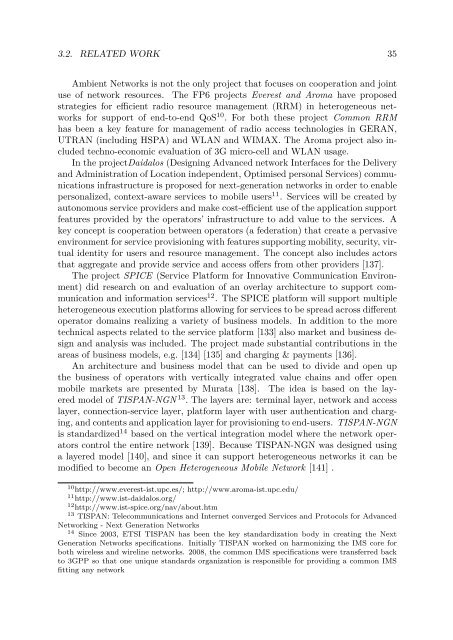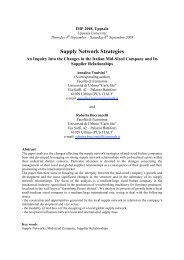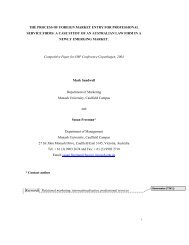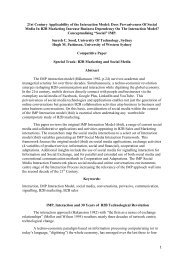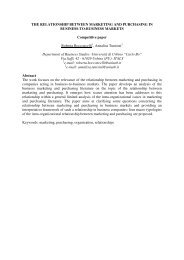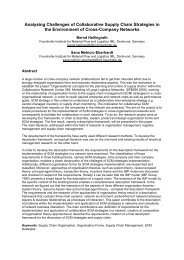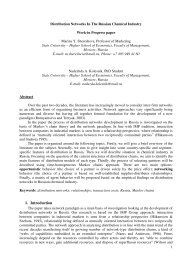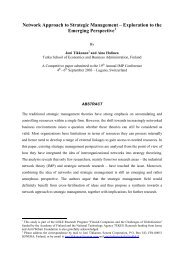Mobile Network Operators and Cooperation - IMP Group
Mobile Network Operators and Cooperation - IMP Group
Mobile Network Operators and Cooperation - IMP Group
You also want an ePaper? Increase the reach of your titles
YUMPU automatically turns print PDFs into web optimized ePapers that Google loves.
3.2. RELATED WORK 35<br />
Ambient <strong>Network</strong>s is not the only project that focuses on cooperation <strong>and</strong> joint<br />
use of network resources. The FP6 projects Everest <strong>and</strong> Aroma have proposed<br />
strategies for efficient radio resource management (RRM) in heterogeneous networks<br />
for support of end-to-end QoS 10 . For both these project Common RRM<br />
has been a key feature for management of radio access technologies in GERAN,<br />
UTRAN (including HSPA) <strong>and</strong> WLAN <strong>and</strong> WIMAX. The Aroma project also included<br />
techno-economic evaluation of 3G micro-cell <strong>and</strong> WLAN usage.<br />
In the projectDaidalos (Designing Advanced network Interfaces for the Delivery<br />
<strong>and</strong> Administration of Location independent, Optimised personal Services) communications<br />
infrastructure is proposed for next-generation networks in order to enable<br />
personalized, context-aware services to mobile users 11 . Services will be created by<br />
autonomous service providers <strong>and</strong> make cost-efficient use of the application support<br />
features provided by the operators’ infrastructure to add value to the services. A<br />
key concept is cooperation between operators (a federation) that create a pervasive<br />
environment for service provisioning with features supporting mobility, security, virtual<br />
identity for users <strong>and</strong> resource management. The concept also includes actors<br />
that aggregate <strong>and</strong> provide service <strong>and</strong> access offers from other providers [137].<br />
The project SPICE (Service Platform for Innovative Communication Environment)<br />
did research on <strong>and</strong> evaluation of an overlay architecture to support communication<br />
<strong>and</strong> information services 12 . The SPICE platform will support multiple<br />
heterogeneous execution platforms allowing for services to be spread across different<br />
operator domains realizing a variety of business models. In addition to the more<br />
technical aspects related to the service platform [133] also market <strong>and</strong> business design<br />
<strong>and</strong> analysis was included. The project made substantial contributions in the<br />
areas of business models, e.g. [134] [135] <strong>and</strong> charging & payments [136].<br />
An architecture <strong>and</strong> business model that can be used to divide <strong>and</strong> open up<br />
the business of operators with vertically integrated value chains <strong>and</strong> offer open<br />
mobile markets are presented by Murata [138]. The idea is based on the layered<br />
model of TISPAN-NGN 13 . The layers are: terminal layer, network <strong>and</strong> access<br />
layer, connection-service layer, platform layer with user authentication <strong>and</strong> charging,<br />
<strong>and</strong> contents <strong>and</strong> application layer for provisioning to end-users. TISPAN-NGN<br />
is st<strong>and</strong>ardized 14 based on the vertical integration model where the network operators<br />
control the entire network [139]. Because TISPAN-NGN was designed using<br />
a layered model [140], <strong>and</strong> since it can support heterogeneous networks it can be<br />
modified to become an Open Heterogeneous <strong>Mobile</strong> <strong>Network</strong> [141] .<br />
10 http://www.everest-ist.upc.es/; http://www.aroma-ist.upc.edu/<br />
11 http://www.ist-daidalos.org/<br />
12 http://www.ist-spice.org/nav/about.htm<br />
13 TISPAN: Telecommunications <strong>and</strong> Internet converged Services <strong>and</strong> Protocols for Advanced<br />
<strong>Network</strong>ing - Next Generation <strong>Network</strong>s<br />
14 Since 2003, ETSI TISPAN has been the key st<strong>and</strong>ardization body in creating the Next<br />
Generation <strong>Network</strong>s specifications. Initially TISPAN worked on harmonizing the IMS core for<br />
both wireless <strong>and</strong> wireline networks. 2008, the common IMS specifications were transferred back<br />
to 3GPP so that one unique st<strong>and</strong>ards organization is responsible for providing a common IMS<br />
fitting any network


